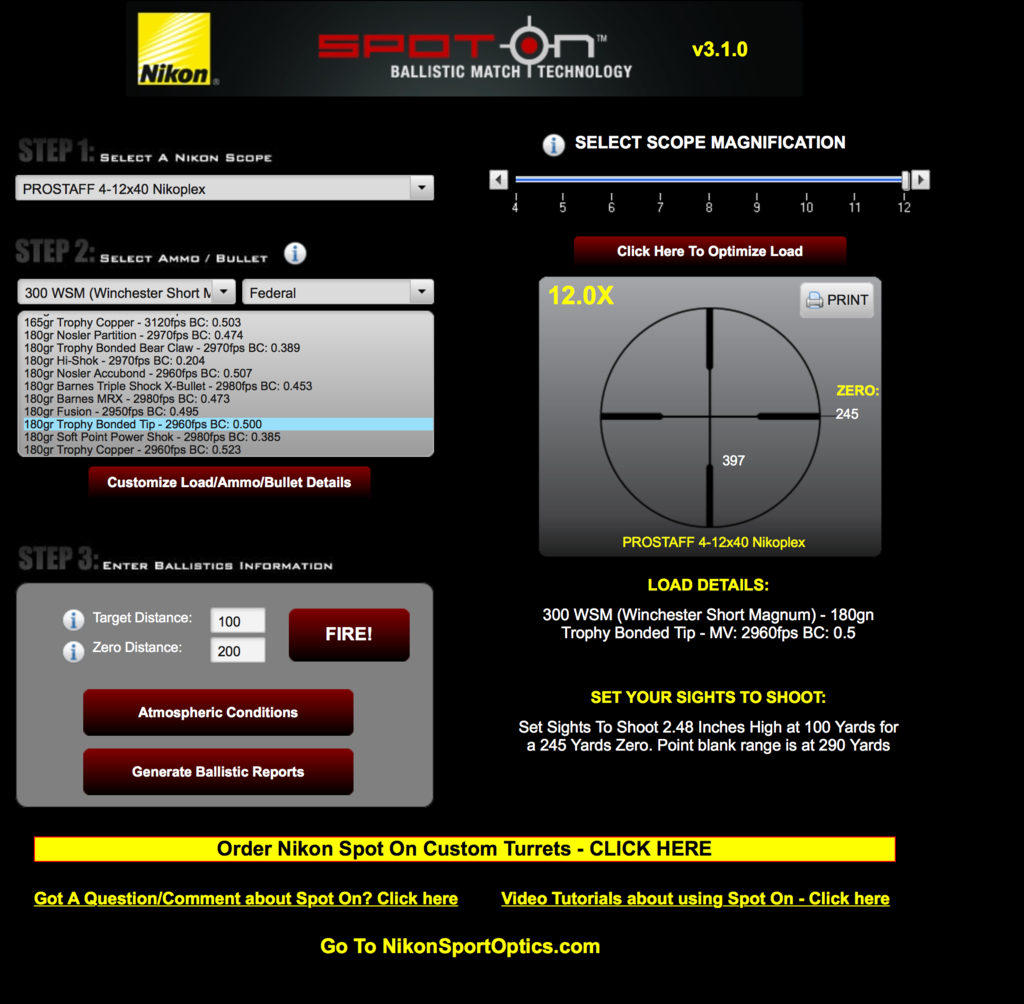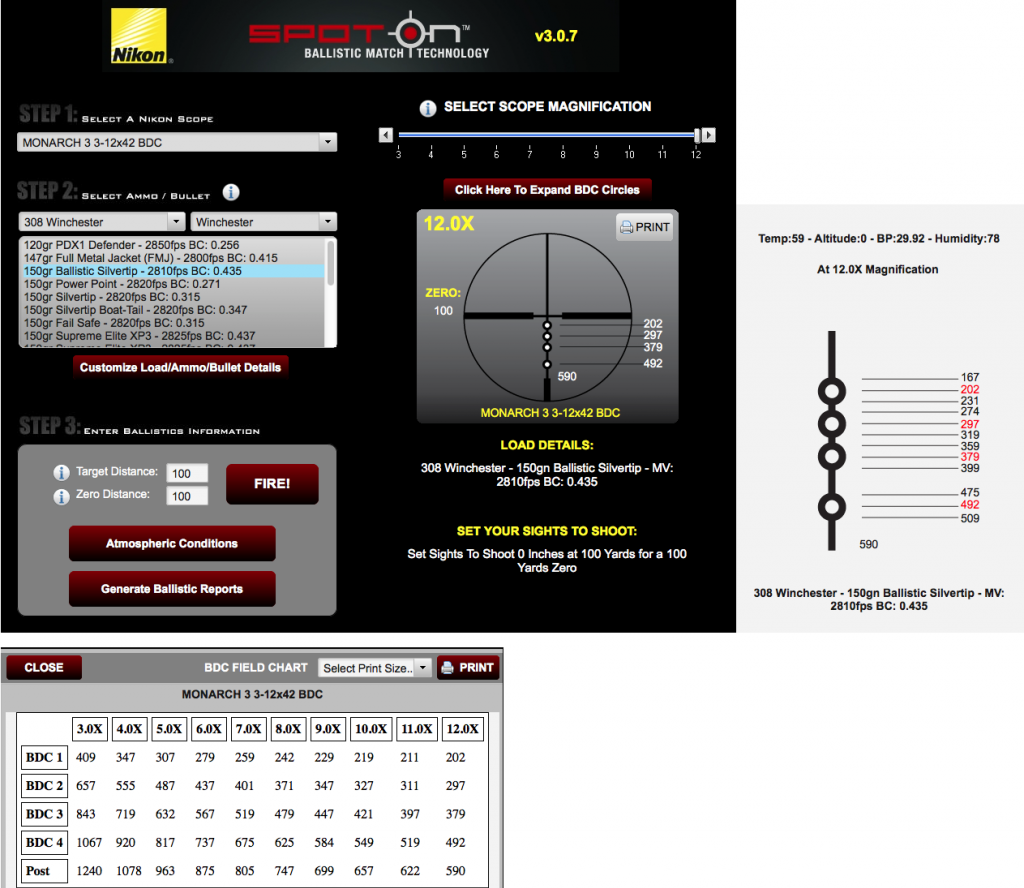Originally posted by meltingfeather
View Post
Announcement
Collapse
No announcement yet.
Any BDC reticle fans?
Collapse
X
-
I had a Nikon scope with the bdc and it worked greatOriginally posted by jason86 View PostI’ve had both but would rather my zero be specific to the range I’m shooting. I guess in a perfect world, which is possible, I would have both. If I can range and set the turret then fine, but if I’m in a pinch and the target won’t stop moving I guess the bdc would be good in a quick situation.
Comment
-
They may not be the best choice for a dedicated long range target rifle, but you don't always have the time to tweak turrets in a hunting situation, and IMO that's where the Nikon BDC reticle shines. I don't own a scope of any other kind for daytime rifles, from a .450 Bushmaster to my A-Bolt .300 WSM, and everything in between.
Comment
-
If you don't want to dial and don't want to use the circles, Nikon's Spot On program will let you optimize your load. Select a non-BDC reticle scope, enter shooting info and then you can select the vital sized area of your target. This will then tell you where you need to impact at 100 yards and still be able to make a lethal shot. Very helpful and I know some older guys who use it on their BDC scopes just because they don't want to shoot that far and they don't want to lose an animal.

Comment
-
When the BDC style reticles first came out I was completely against them and thought they were stupid since they could never be "right". There are too many variables to make a universal reticle and call it good for everything.
As they got more common and marriage and kids put a crimp in the amount of money I could spend on optics I started do a little more digging and I have come to accept them for what they are. I have also come up with a method of making them a bit more useful.
The general principle behind all of them is that you zero your weapon at 100 or 200 yds/m and the the subsequent dot/circle represent your POI at yardage increments (200,300,400,500). The thing to remember is that while bore angle relative the line of sight is what we are really adjusting with our sights, linear deviation at the target in inches is what we are truly interested in. We also need to understand that a bullets path (in the absence of wind and Coriolis) is a parabola that can be defined by a precise equation. If you give me the launch angle and the vertical height of the projectile at 3 ranges I can predict very accurately what the height of the projectile will be at any other range. The further the 3 known ranges are apart from each other the more precise the calculations will be be. In other words if I know the projectile height at 100,200, and 300 I can get pretty close at 400, 500, and 600. As you start getting further the error is cumulative and it will start to get pretty large. If on the other hand you give me the projectile height at 100, 300, and 500 then the accuracy of the prediction will carry out to further ranges.
So where am I going with all of this? You cannot change the spacing of the aiming points on a BDC reticle since they are all in SFP scopes.....but wait a minute, you can! You can adjust the magnification. So now knowing that all bullets travel a parabolic path and knowing that in terms of angles the paths are all very similar we have something to work with when it comes to hunting applications.
I think we all have heard and used the general rule of thumb that if you sight your rifle in 2" high at 100yds you will be pretty close to dead on at 200. This is true because with 90% of modern cartridges the shape of their parabolas are all very similar. Knowing this we can do a little redneck engineering and this is what I do.
For a hunting rifle I only care that if I hold on the animal the vertical error is small enough that bullet still hits the animal in a vertical band that is within the vital. Obviously the larger the animal the larger the vertical band is. The jist of what I do is as follows.
Zero the rifle at 100 on a large target frame with the target near the top. I then move back to 300/400/500 yds depending on the cartrigde and using the same point of aim with the main crosshair I shoot another group. I then go down range and mark the group with something that is visible from the firing line. Then go back to the firing line and place the main cross hair on the original point of aim and adjust the magnification until the marker I placed in the center of the group is centered up in the corresponding circle/dot.
I now know that at that magnification that 400 or 500yd indicator is dead on (for those conditions). The way the physics and math works the 200, 300, 400 are all now very close since I basically nulled out the error at a significant distance. I also place a mark on my mag ring to know where it needs to be set for the reticle to be correct. This magnification is always near the max which is fine since if the range is far enough to need to worry about bullet drop the resulting reduced field of view is fine.
Comment
-
175, Dead on! I do the same thing on a regular basis. I chrono my load, measure scope height and try to get the most accurate information into Spot On so that my results will be equally accurate. I then look for the magnification setting that gets me closet to whole numbers and I do print the card showing distances for each magnification setting. Easy to do and accurate. Another nice feature of Spot On is that if you use a FFP scope there are no worries about what magnification setting you are using, the distances you get are the ones you use no matter what setting. I have one on .300 BO scope that I will be swapping out soon. A .308 would be a much better choice over a cal. like the BO that needs a boost by dropping the magnification setting to increase BDC distance.

Comment
-
It’s good to remember that any reticle with vertical detents can be used like a BDC... and any BDC can be used for alternate holdovers.
My ZEISS is a RapidZ 600 that I needed to shoot at 750 yards, so I used the ZEISS app to figure out the magnification that would put the 600 yard holdover at 750 yards.
Boom... 4 hits on the plate out of 6 shots.
Standing on sticks with a 7 lb. rifle.



Comment
-
Bullet drop is the easiest part of the calculation. That can be figured very easily with accurate data to input. Wind and weather are what will get you on long range shots. Hold over can be very accurate with the right reticle and complete knowledge of what everything represents. That said, I range and dial using a ballistics app and wind meter.
Comment
-
Great to hear, Grape. You obviously took the time to enter the data correctly. I get such a chuckle out of Spot On and Nikon's BDC scopes. I taught my Father-In-Law and my son how to use both. My FIL was 75 when he first used one after I took away his iron sited antique he used to miss deer with. Sat down at the table with printouts and we walked through it all. Went to the range and just getting him used to a scope was a challenge. After the Korean war and countless years of hunting and missing he suddenly saw the light. Over the next 7 years, he harvested at least 12 deer all with one shot stops and out past 300 yards. I hunted with him, reminded him but he made the shot count. Now teaching my 10-year-old son was a lot easier. We sat down at the computer entered all the shooting data and discussed what each entry meant. We then went to the range and it was a piece of cake. We were invited to a Damage Control hunt in Shamrock, TX soon after that and my son took 12 deer. I called out the range and he dropped tot he propper aiming circle and it was a done deal. Old and new, Spot On works if you just give it a chance.
Comment

Comment